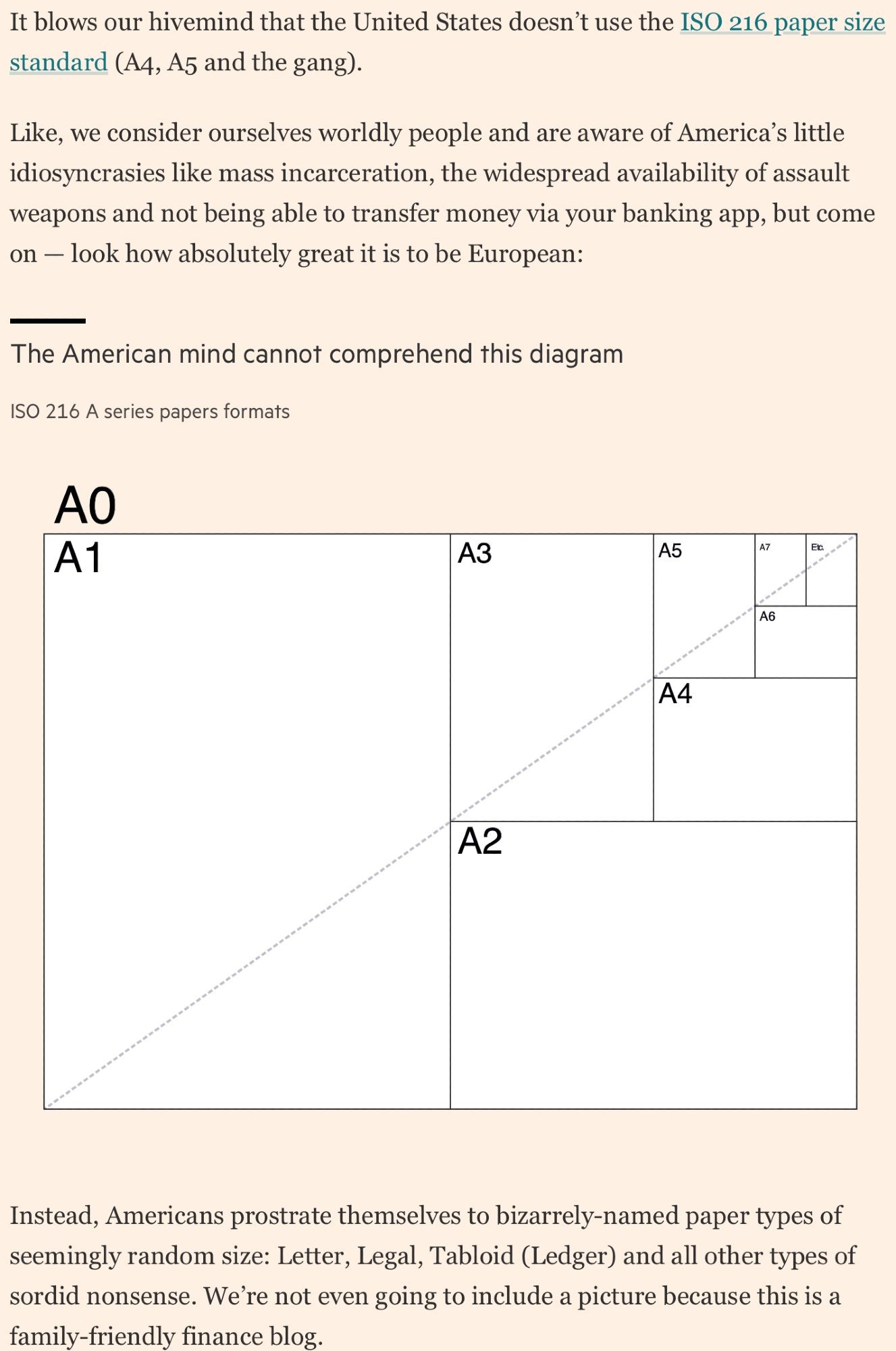this post was submitted on 28 May 2024
1061 points (100.0% liked)
196
16509 readers
2360 users here now
Be sure to follow the rule before you head out.
Rule: You must post before you leave.
founded 1 year ago
MODERATORS
you are viewing a single comment's thread
view the rest of the comments
view the rest of the comments

Letter paper (8.5" x 11" | 215.9mm x 279.4mm) is kinda sorta pretty close to A4 (8.27" x 11.69" | 210mm x 297mm) so without having the two next to each other, it can seem like A4 is just a funny piece of letter, and vice versa. But to answer the actual question, USA and Canada (and apparently the phillipines???) use the "North American Standard" which is a terrifying mess in comparison to the beauty that is the ISO standard.
Edit: typos
Philippines makes sense, being a former US colony
The US is a former British colony, but it doesn't stop them from doing whatever the hell they want. Utter lunatics...
I'm sorry, I still haven't forgiven them for the whole tea thing...
We wanted to make sure it was as salty as King George III.
America tried to modernise many British means of methods and standards. They used a metric currency long before Britain. That’s why they have a cent (1/100) rather than pennies and bobs and truppence.
They got ride of many terms for multiples of measurements that made the imperial system more similar to metric. Americans use ounces, but they don’t use pounds.
America also defines their us customary units using metric. There’s no longer an inch. There is a meter and from that an inch is defined as 24 millimeters. This is largely due to British, Canadian and American components for fighting wars not fitting together despite all using the same inch.
Had America modernised a little later they probably would have converted to metric earlier than Britain.
Tbf, I can see the use case for some "non-standard" sizes, like Legal, where having more height to the page without the extra width might be useful for readability of long documents.
...can't think of an excuse for the rest, though.
That's how it starts, you see the usefulness of one case, the next thing you know is you're measuring distance in sheep and power in mice
Hamsters, not mice. Get it right.
And always fractional, so, to convert from Farenheit to Celsius (inferior to kelvin, though), you take farenheit, add 57 mice, and divide by a hamburger.
As a European, I do appreciate Legal as a format.
It just happens slightly too often that an A4 is not long enough and the last bit, including the signature, goes to the next page.
I wish Legal was common here. Or perhaps we could get a Long A4 with a third extra height or so.
The Letter format should just be replaced by A4 though.
As a European, haven't you heard about the existence of the B and C series of paper sizes? It may not be exactly what you have in mind, but B4 paper is 250 x 353 mm (9.8 x 13.9 in) and C4 paper is 229 x 324 mm (9 x 12.8 in). There's also elongated A which is really long.
I hope you appreciate the irony of an American telling you about them.
There's also scrolls, if Elongated A isn't quite enough.
Tried these but my printer always gets caught on the wooden handle things 😜🤪
Time to update to a fax machine then!
https://www.possupply.com/other-pos-supplies-accessories/fax-paper-rolls-ribbons
I do miss the continuous form paper used with dot matrix printers.
It made banners easy, and I could make snakes out of the edges.
Burn the unbeliever!
As your links explain, C series is used for envelopes, while B and elongated A are special case that aren't commonly used.
In any case, none of those series has an equivalent to American Letter.
The only paper that you will commonly find in European offices are A4 and (to a lesser extent) A3.
A big office printer might have 4 trays stocked with A4 and one tray with A3, for example.
I think Mexico too, or at least the paper name is "carta" and "oficio" which would translate to letter and legal (kinda)